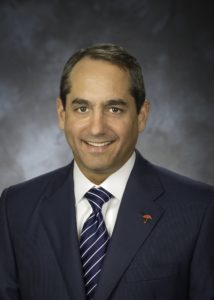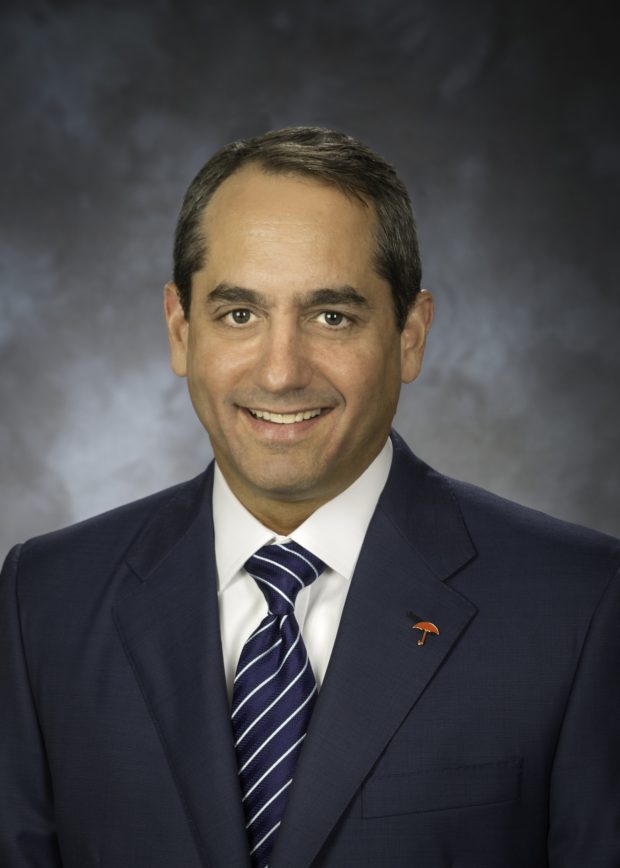Challenges that fueled prior-year loss reserve development of nearly $300 million at Travelers aren’t a problem that is unique to the insurer, executives noted during an third-quarter 2019 earnings conference call Tuesday.
The quarter’s $294 million pre-tax reserve charge, a reaction to a worsening tort environment, helped to push third-quarter net income down 44 percent to $396 million, compared to $709 million for third-quarter 2018. But commercial insurance price hikes that Travelers has pushed through in reaction to emerging loss issues haven’t driven customers away, they also noted, suggesting there’s room for more.

Alan Schnitzer, chair and chief executive officer of Travelers, said that while the carrier saw continued favorable development in workers compensation, prior-year reserves and current year loss picks for other parts of the business insurance book had to be increased. Specifically, the company added $220 million for asbestos liabilities—similar in magnitude to a $225 million boost in third-quarter 2018. But unlike the situation in last year’s third quarter, workers comp takedowns were not enough to hide more needed hikes in the general liability and commercial auto lines.
Those two lines, Schnitzer said, were impacted “by a tort environment that has deteriorated beyond our elevated expectations.”
Pointing to a graph of average paid claim costs for commercial auto bodily injury taken from ISO data for the industry, which showed a wide gap between actual average costs for the four quarters of 2018 and those determined using a fitted trend line (based on actual quarterly data from first-quarter 2015 through fourth-quarter 2017), Schnitzer said, “We remain confident that this is an industrywide issue and that we’re responding appropriately to recently emerging data.”
“This view of industry data for other commercial liability coverages is not yet available for 2018, but we believe that the more aggressive tort environment is, to one degree or another, impacting those as well. While the chart reflects industry data [and] is not Travelers-specific, [it] illustrates the challenge we’ve been addressing as part of our current and prior-year reserve [analysis] over the past four quarters.”
“Developing a stable view of ultimate losses in this case is made difficult by the magnitude of the shift in the data combined with the fact that it is so recent,” he said, highlighting the “long-term nature of the exposure and a lengthening of the claim development pattern, which is difficult to assess as it emerges.”
Chief Financial Officer Daniel Frey noted that the $294 million reserve boost added 4.1 points to the third-quarter calendar year combined ratio, which wound up at 101.5, compared to a 96.6 for third-quarter 2018. In addition, both Frey and Schnitzer also described adjustments to re-estimate commercial auto and general liability loss picks for the first and second quarters, adding another two-thirds of a point to the underlying combined ratio on a year-to-date basis.
Still, the executives had good news to report about the third-quarter top line. Net written premiums jumped 7 percent, or $500 million, across commercial, personal and specialty lines overall to $7.6 billion, reflecting high levels of retention, improving renewal premium changes and higher levels of new business.
In business insurance, in particular, Travelers achieved an average renewal premium change of 7.4 percent—the highest level in more than five years—with a retention rate of 84 percent on domestic business.
 Schnitzer said that’s not the case. “We’re executing one account at a time…. We’re making the right decisions on price and retention, we think. But I think one takeaway that we take from the [continued high level of] retention is that there is certainly more room to go.”
Schnitzer said that’s not the case. “We’re executing one account at a time…. We’re making the right decisions on price and retention, we think. But I think one takeaway that we take from the [continued high level of] retention is that there is certainly more room to go.”
He continued: “The market is not pushing back on us, which is evidence that these really are environmental issues….We think there’s more room to go. Also, in terms of our customers and our distribution relationships, [we’re] doing this thoughtfully, slowly, steadily. I think there’s a lot of benefit to that. So, that’s part of our execution strategy.”
Another analyst questioned whether Travelers should deliberately start letting retention levels drop in light of the worsening liability loss trends.
Travelers doesn’t think about the situation that way, Schnitzer responded. “We don’t ring a bell and say grow or ring a bell and say don’t grow,” he said. “We execute one account, one class of business at a time, and we do that with a return focus.
“We’re out there executing on our accounts, trying to retain the ones we want [at] the prices and terms and conditions that we want. And we’re out there hustling new business that we find attractive and that meets our return objectives. And when the sum of those things adds up to growth, we’ll grow. When it doesn’t, we won’t,” he said.
Reserve Charge Details
The overall reserve charge of $294 million before taxes, translated to 4.1 third-quarter combined ratio points. After taxes, the income hit was $232 million.
For business insurance alone, Travelers recorded $316 million of unfavorable prior-year development, with $220 million stemming from asbestos liabilities and $88 million from other than A&E, while personal and bond and specialty insurance segments showed small amounts of favorable development.
Breaking down the $88 million “all other” component by line of business, Frey said that $134 million came from strengthening to general liability reserves and $114 million for strengthening commercial auto reserves, partially offset by takedowns in the workers comp and property lines.
Overall, the asbestos and other changes combined added 8.1 points to the business insurance combined ratio for the quarter.
Analysts zeroed in on the fact that Travelers reported increases to prior-year loss reserves and current year loss picks for commercial auto and general liability in several recent quarters. Why haven’t other insurers doing the same? Is Travelers book different?
“My instinct is no,” said Schnitzer, pointing to the ISO data. “We believe this is environmental.”
“The rate of attorney involvement and the aggressive behavior is up and I think that’s going to impact anybody writing liability coverages,” he said, pointing to lawyer advertising on television.
Schnitzer was also asked twice to assure investors that there would be no more reserve boosts, something he would not be coaxed to do.
“I wish I could stand up and guarantee that we’ve got it and this will never happen again. Obviously, I can’t do that. I don’t think anyone can do it. And I’d point to the magnitude of the shift, which is very recent information in a long-tail line. The lengthening of the claim development pattern really does complicate our ability to assess it….And it’s taken us a couple of quarters to get to where we are. We’re going to get another quarter’s worth of data in a couple of months here and we’ll see where that comes in.”
“There is an incremental level of confidence that comes from the fact that we’ve now got a couple of quarters strung together and a view on what a new trend line might be… But I can’t tell you now where the next dot was going to come in on the chart or what that’s going to do to the trend line. It’s data we haven’t seen yet,” he said, near the end of the call.
As part of an even longer response to the first questioner on the call, who also wanted the CEO to say that reserve hikes were a done deal, Schnitzer concluded by saying, “We continue to think running the business by the numbers, being very disciplined about that is the right way to do it.…We have got a long track record of managing that way over time. We think we’re running it the right way and we think we have got the right estimate now. But I don’t think we or anybody could give you a guarantee.”
“Essentially, what you’re saying is that you are as confident as you can be that this issue is addressed, right?” the analyst prodded.
Schnitzer reworded the analyst’s statement. “I’m just as confident as I can be that this is our best estimate,” he said.
Broken Tort System

During his introductory remarks, Schnitzer said that tort reform has been a public policy focus for Travelers. “We’re stepping up our efforts,” he added.
At Travelers, “we will manage through this [reserving complexity], but the bigger issue for all of us is that the broken tort system imposes the tort tax across society,” he said.
“At the heart of the issue is a higher and more aggressive level of attorney involvement on claims,” he said.
He noted that a recent study by the Institute for Legal Reform estimated that tort costs amount to roughly 2.3 percent of U.S. GDP or more than $3,300 per U.S. household–and considerably more than that in some states. (“Costs and Compensation of the U.S. Tort System,” October 2018)
“There’s also evidence that some claimants can be disadvantaged,” Schnitzer said, pointing to an Insurance Research Council report finding that private passenger claimants with attorneys received less, on average, from insurance settlements (after deducting legal and other related costs) than claimants without attorneys. On average, it also takes claimants with attorneys longer to receive payments, he said.





















 Federal Aviation Notice Warned of Slackline Before Deadly Arizona Helicopter Crash
Federal Aviation Notice Warned of Slackline Before Deadly Arizona Helicopter Crash  Underwriter, Actuary Fears of AI Drop; Work Needed on Collaboration
Underwriter, Actuary Fears of AI Drop; Work Needed on Collaboration  Nearly Half of 100 Largest P/C Insurers Destroy Value: ACORD
Nearly Half of 100 Largest P/C Insurers Destroy Value: ACORD  Artificial Intelligence Is Rewriting the Rules for Commercial Lines
Artificial Intelligence Is Rewriting the Rules for Commercial Lines 


